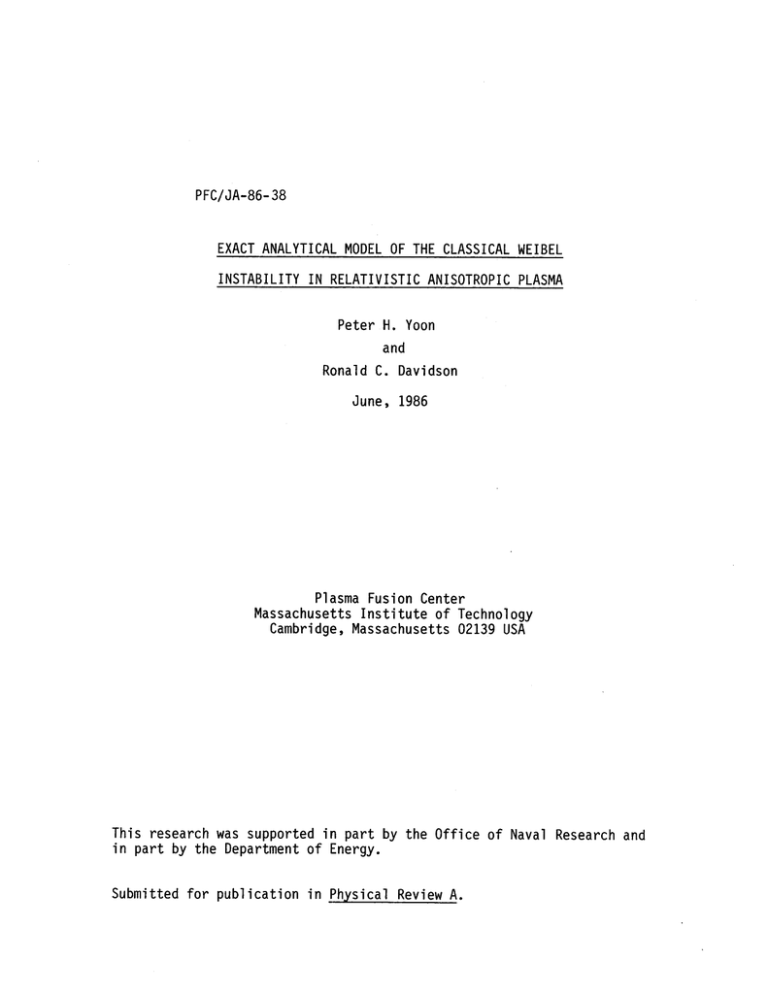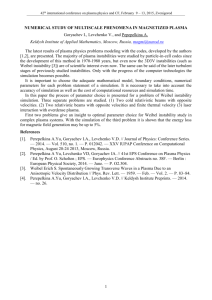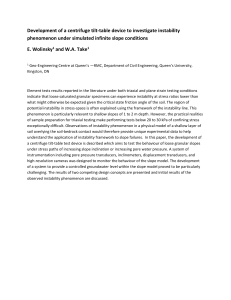PFC/JA-86-38 EXACT PLASMA Peter H. Yoon
advertisement

PFC/JA-86-38 EXACT ANALYTICAL MODEL OF THE CLASSICAL WEIBEL INSTABILITY IN RELATIVISTIC ANISOTROPIC PLASMA Peter H. Yoon and Ronald C. Davidson June, 1986 Plasma Fusion Center Massachusetts Institute of Technology Cambridge, Massachusetts 02139 USA This research was supported in part by the Office of Naval Research and in part by the Department of Energy. Submitted for publication in Physical Review A. EXACT ANALYTICAL MODEL OF THE CLASSICAL WEIBEL INSTABILITY IN RELATIVISTIC ANISOTROPIC PLASMA Peter H. Yoon and Ronald C. Davidson Plasma Fusion Center Massachusetts Institute of Technology, Cambridge, Massachusetts 02139 ABSTRACT Detailed properties of the Weibel instability in a relativistic unmagnetized plasma are investigated for a particular choice of anisotropic distribution function F(p ,PZ) that permits an exact analytical solution to the dispersion relation for arbitrary energy anisotropy. The particular equi- librium distribution function considered in the present analysis assumes that all particles move on a surface with perpendicular momentum p- = pj = const. and are uniformly distributed in parallel momentum from pz pz ~ +z = const. ~z . = const. to (Here, the propagation direction is the z-direction.) The resulting dispersion relation is solved analytically, and detailed stability properties are determined for a wide range of energy anisotropy. 2 The classical Weibel instability 1,2 in a uniform plasma is a transverse electromagnetic instability driven by an anisotropy in the average kinetic energy of the constituent electrons and/or ions. This instability has a wide range of applicability to astrophysical plasmas, 3,4 with intense microwave heating. and to laboratory plasmas 4 For nonrelativistic anisotropic plasma, for detailed properties of the Weibel instability are readily calculated 1,2 a wide range of equilibrium distribution functions F.(p ,pz). For relativistic anisotropic plasma, however, because of the coupling of the perpendicular and parallel particle motions through the relativistic mass factor y= (1 + p2/m c2 + _LiJ pz/mj c2 )1, stability properties are usually calculated in the limit of extreme energy anisotropy, or long perturbation wavelength, 4 which allow approximate analytical solutions to the electromagnetic dispersion relation. Here, "perpendicular" and "parallel" refer to directions relative to the propagation direction (the z-direction). The purpose of the present brief communication is to investigate detailed properties of the Weibel instability in a relativistic unmagnetized plasma for a particular choice of anisotropic distribution function that permits an exact analytical solution to the dispersion relation for arbitrary energy anisotropy. This calculation is intended to provide qualitative insights regarding stability behavior for more general choices of equilibrium distribution function. The particular distribution function [Eq.(3)] considered in the present analysis assumes that all particles move on a surface with perpendicular momentum p1 = p = const. and are uniformly distributed in parallel momentum between pz = ~-z = const. and pz = = const. The resulting disper- sion relation [Eq.(8)] can be solved analytically, and detailed stability 3 properties are determined for a wide range of energy anisotropy. The dis- persion relation [Eq.(15)] is also derived for the case where the particles have a thermal equilibrium distribution in parallel momentum pz [Eq.(13)], and the corresponding range of unstable wavenumbers is determined in closed form [Eq.(18)]. Extension of the present analysis to include a uniform applied magnetic field B will be the subject of a future investigation. A. Theoretical Model We investigate the electromagnetic stability properties of relativistic anisotropic plasma for wave perturbations propagating in the z-direction with wavevector k = kz . Perturbations are about the class of uniform, field-free equilibria with distribution function f9(p) = n Fj(p ,spz) (1) where 6. = const. is the ambient density of the j'th plasma component, p = (p + p ) is the particle momentum perpendicular to the propagation direction, and pz is the parallel momentum. In the absence of applied magnetic field, the linear dispersion relation for transverse electromagnetic wave perturbations propagating in the z-direction is given by C 2k 2 0 = DT(kzw) = 1 - ) - I: W2-d 3p (p /2) f y (w -(pY k ZP/Ym) (2) kz z x Here, 2== 4irn e./m --- - + kzp +F a 2 (p,pzZ is the nonrelativistic plasma frequency-squared; e and m. are the charge and rest mass, respectively, of a j'th component particle; c is the speed of light in vacuo; y = (1 + pl/m c2 + p2 /m c2 )1 is the relativistic mass factor; the range of integration is fd 3p 21Tf dp p1 fdpz 0 -0 4 and the normalization of F is fd 3 pF.(p , p) 1. In obtaining Eq.(2), the perturbations are assumed to have z- and t-dependence proportional to exp[i(kz z - WOt)], where kz is the wavenumber and w is the complex oscillation frequency with Imw > 0, which corresponds to instability (temporal growth). For relativistic anisotropic plasma, we note that the perpendicular and parallel particle motions in Eq.(2) are inexorably coupled through the relativistic mass factor y = (1 + p2/m c2 + p /m c2f In the analysis that follows, we specialize to the case of stationary ions (m + o) and consider a single active component of relativistic anisotropic electrons. Moreover, for simplicity of notation, the electron species labels are omitted from we , m , F ( The resulting dis- pz), etc. persion relations [Eqs.(8) and (15)] are readily generalized to the multicomponent case. B. Waterbag Distribution in Parallel Momentum The dispersion relation (2) can be used to investigate detailed electromagnetic stability properties for a wide range of anisotropic distribution For purposes of elucidating the essential features of the functions F(p ,pz). Weibel instability in relativistic anisotropic plasma, we make a particular for which the momentum integrals in Eq.(2) can be carried choice of F(p ,pz) out in closed analytical form. In particular, it is assumed that the electrons = const. and are uni- move on a surface with perpendicular momentum p, = formly distributed in parallel momentum between pz +pz = const. = = const. and pz That is, F(pL,pz) is specified by 21 F(pji,pz) = 2r 6 (pj - J) 1 ( H( 2 2 -zp ) ,(3) where H(x) is the Heaviside step function defined by H(x) and H(x) = 0 for x < = +1 for x > 0, 0. Note from Eq.(3) that fd3 pF(p ,pz) = 1. Because ~ 5 the electrons are uniformly distributed in parallel momentum for Ipz < Z, we refer to the pz-dependence of the distribution function in Eq.(3) as a "waterbag" distribution in pz the maximum energy For future reference, it is useful to introduce mc2, parallel speed caz, and perpendicular speed ca defined by imc ymC .2 1 2 i mc= + (4) We further introduce the effective perpendicular and parallel temperatures defined by d3P T1 = f 2 2ym F(p ,p ) Z 2ym (5) -T 2 3 2 2 (d3p F(pZpp)' = 2 T2ym Substituting Eq.(3) into Eq.(5) and carrying out the required integrations over p1 and pz give = T,= - ymc2 aG(iz ' (6) 1.[1 T = Ymc + - 2-2 G(az) +O G(Oz] where G(az) is defined by 1 G( Z) = 1+ in 2az Z I (7) z From Eq.(7), we note that G(az) is a slowly increasing function of az with G() =1 + /3' for 2 < 1. Moreover, in the limit of a nonrelativistic 6 plasma with T + z << 21 and (1/2)mc 2 and T H + 2 <<2A 1, Eq.(7) reduces to the expected results, (1/3)mc 2. Depending on the relative values of 8 and az, it is clear that the choice of distribution function in Eq.(3) can cover a wide range of energy anisotropy. For the choice of distribution function F(p ,pz) in Eq.(3), the pand pr- integrations required in Eq.(2) can be carried out in closed ana- lytical form. Some straightforward algebra that makes use of Eqs.(2), (3), (4) and (7) gives the dispersion relation c2k2 2 0 = DT(kzw)r - G(z L W c k2 _ 2 02 1 + - (8) .2 z 2 (1 - W) - c k aI Equation (8) is readily extended to the case of a multicomponent plasma by making the replacements (w 21/) EAw + + - - - ,z ) A A1 j' A A + aj, etc. For a single active (electron) component, Eq.(8) can be expressed in the equivalent form 2 -2 0 4 2 2 c2k Z(1+ ^2) 2+ 2 ^2 B -2 - ^2(1 z 2z - j - G(zI (9) 2 + 2 2k 1~ ^ - _20Z(1 -z which is a quadratic equation for w2. G( z)' j In Eq.(9), w2 = 4,, Ae 2 /m is the non- relativistic electron plasma frequency-squared, and G( z) is defined in Eq.(7). The dispersion relation (9) can be solved exactly for the complex oscillation frequency w. In this regard, a careful examination of Eq.(9) shows that there are two classes of solutions for w2, namely, a fast-wave 7 branch corresponding to stable oscillations with Imw = 0 and (Rew)2 > c2 k2z, and a slow-wave branch which may or may not exhibit instability, depending on the degree of energy anisotropy. It is readily shown that the necessary and sufficient condition for the slow-wave branch to exhibit instability (Imw > 0) is given by 2 > (1 - (10) R)G(z zz Moreover, when Eq.(10) is satisfied, the corresponding range of k2 corresponding to instability is given by 2 .2 0 < k2< k J ic 2AZII - G(Az (1 S When Eq.(10) is satisfied, and kz is in the range specified by Eq.(11), the real oscillation frequency of the slow-wave branch satisfies Rew = 0 and the growth rate of the unstable mode is given by +2 1 Im ( c2k c2 (k$ - k ) - /2 2 - -2 + 4c4k a (k0 - kZ) Y 20 - c2k & + '- - c2(k - k) 2 z Note from Eq.(12) that Imw = 0 for kz =z0 and k z = k2, 0' and that Imw passes through a maximum for some value of k intermediate between 0 and k2. In the nonrelativistic limit with ^.,I 2 < 1, the necessary and sufficient condition for instability in Eq.(10) becomes $I/2% stability is given by 0 < k < k ( /C ± 1/2a > 1, and the range of in- - 1). In the relativistic regime, however, the instability criterion in Eq.(10) is more complicated, which is illustrated in Fig. 1. In Fig. 1, the region of ($ ,2R) parameter space corresonding to instability is above the contour connecting the origin to ( ,2 ) = (0.580,0.840), which corresponds to y = >. While the detailed 8 form of the instability criterion in Eq.(10) differs from the nonrelativistic case, it is evident from Fig. 1 that the condition for instability in the relativistic regime is qualitatively the same, i.e., the Weibel instability exists for sufficiently large values of s2/2a2. Put another way, for the choice of distribution function in Eq.(3), the Weibel instability in a relativistic anisotropic plasma can be completely stabilized by increasing the thermal anisotropy 22/R2 to sufficiently large values. As a numerical example, shown in Fig. 2 are plots of normalized real frequency Rew/[w p/i] [Fig. 2(a)] and growth rate Imw/[w p/i] [Fig. 2(b)] versus normalized wavenumber ckz /[W anisotropy /2 il] for 9 = 9 and several values of energy The real oscillation frequencies for both the fast-wave . and slow-wave branches are presented in Fig. 2(a). Moreover, for 9 slow-wave branch becomes completely stable (Imw = 0 and k2 0.697. = 0) for = 9, the /2az = It is evident from Fig. 2(b) that the strongest instability occurs for the largest energy anisotropy, i.e., A2z = 0 and /2, Moreover, depending on the value of _2 = 80/81 (for 9 = 9). the maximum growth rate in Fig. 2(b) can be a substantial fraction of w /9 . C. Thermal Equilibrium Distribution in Parallel Momentum As a second example, we consider the case where the electron distribution function is specified by 2 F(p ) -1 27rp exp(-ymc 2/T 1 I - kd 2 2y mcK1 (9Lmc /T1 ) 6(,pzpL (13) + co), and a single com- ponent of relativistic, anisotropic electrons is assumed. In Eq.(13), Kn(x) Here, the ions are treated as a fixed background (mi is the modified Bessel function of the second kind of order n ;y (1+p /m2c2 + is the relativistic mass factor; the constant 9 is defined by 9 p2/m2c2)' z (+ 2/ 22) 1; and T1 is a positive constant. Note that the exponential = 9 factor in Eq.(13) corresponds to a thermal equilibrium distribution in parallel momentum pz. Some straightforward algebra that makes use of Eqs.(5) and (13) shows that T1 can be identified with the parallel temperature fd3p(p2/Ym) x 2 F(p ,PZ), and that the effective perpendicular temperature T = fd3 p(pl/2ym)F(p ,pz) is given by T 1 = - 2 (k)2 K0 (j mc2/T11) (14) y mc2 m 2 Ki(iLmc /T ) m Substituting Eq.(13) into Eq.(2) and carrying out the integrations over P and pz give the dispersion relation =0 D(kzw) T kz (/ w Ko(5lmc2 /T ) 2 K1(~mc /T ) 1I ) 2 2(15) c2 k ) (2 T + -p Ymc c2 k W =1 f dTTKO(C) - K0 ( mc 2/T Y ) 0 In Eq.(15), the complex argument of K0 () is defined by C ( T -II\1 (16) + c k 2 , where Imw > 0 corresponds to instability, and T is defined in Eq.(14). The T-integral in Eq.(15) must generally be evaluated numerically,5, 6 or in the context of asymptotic expansions for large or small values of Ic|. Unlike Eq.(8) [or Eq.(9)], the dispersion relation (15) generally incorporates the effects of collisionless dissipation (Landau damping) by the pz-distribution in Eq.(13). For the slow-wave branch, it can be shown from Eq.(15) that the necessary and sufficient condition for instability is given by - T T where T is defined in Eq.(14). 2 KO(^ mc2 /T [K1 (9)c2/T 2 (17) ) Moreover, when Eq.(17) is satisfied, it is 10 found that Rew = 0 (for the slow-wave branch) over the range of unstable wavenumbers specified by 2 T Y c 1 2 0 < k2 z< k0 KO(y mc 2IT 1 ) 2 K1j(mc /T )I Kj(y mc2/T1 1 ) 2 2(18) K0 ( mc /T 11 ) . 2 Note from Eq.(18) that the marginal stability point ko (where Imw = 0 = Rew) can be calculated in closed analytical form. This follows from the identity Im +0+ 2 c2k 2dTTKO) 0 Yc Rew = 0 2 K mc2/T) (19) 11 Finally, shown in Fig. 3 is a plot of the stability boundary in the parameter space (T /y mc2 , T, 1/ Vmc 2 ) calculated numerically from Eq.(17). The region above the curve in Fig. 3 corresponds to instability, which requires sufficiently large thermal anisotropy TI/TH. ACKNOWLEDGMENTS This research was supported in part by the Office of Naval Research and in part by the Department of Energy. 11 REFERENCES 1. E.S. Weibel, Phys. Rev. Lett. 2, 83 (1959). 2. R.C. Davidson, Handbook of Plasma Physics, Volume 1 (A.A. Galeev and R.N. Sudan, eds., North-Holland Publishing Co., New York, 1983) pp. 521-585; cf., pp. 552-573, and references therein. 3. C.S. Wu and L.C. Lee, Astrophys. J. 230, 621 (1979). 4. N.T. Gladd, Phys. Fluids 26, 974 (1983), and references therein. 5. K.T. Tsang, Phys. Fluids 27, 1659 (1984). 6. P.L. Pritchett, Phys. Fluids 27, 2393 (1984). 7. K. Imre, Phys. Fluids 5, 459 (1961). 12 FIGURE CAPTIONS Fig. 1. Region of (A2,2R2) -L Z parameter space corresponding to instability [Eq.(10)]. Fig. 2 Plots of (a) normalized real frequency Rew/[w IP/] and (b) normalized growth rate Imw/[w p/0] versus ck z/[ p/], for = Fig. 3. 9 and several values of A2/22 [Eq.(9)]. Regions of (T1/j mc2 ,T 1/Ymc2 ) parameter space corresponding to instability [Eq.(17)]. 13 UNPHYSICAL 0.580/ 2 UNSTABLE S TA BLE 0.840 0 0. 0 A2 213z Fig. 1 2.0 14 9.0 y9.0 FAST WAVE Rew A ^P py /2 2 ^2 18 /23z =2.0 ^ 0.0L_ 0.0 - c p/ kz 1/2 Fig. 2(a) 9.0 15 0.9 y=9.0 ^2 ^2 20.0 Imw AI/2 10.0 .0 Wp/y 2.0- 0.0 0. 0 c kz 1/2 Fig. 2(b) 9.0 16 I.0 UNSTABLE TI^mc 2 ST ABLE 0.0 0.0 TImI A M2 Xm Fig. 3 1.0


![[These nine clues] are noteworthy not so much because they foretell](http://s3.studylib.net/store/data/007474937_1-e53aa8c533cc905a5dc2eeb5aef2d7bb-300x300.png)

